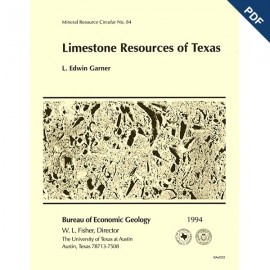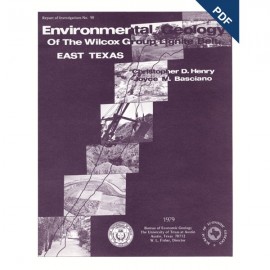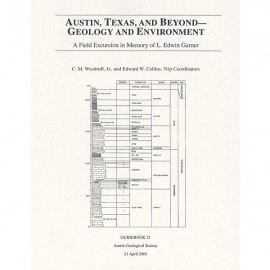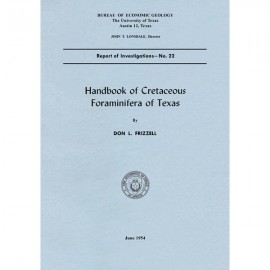Reports of Investigations
-
Books & Reports
- Reports of Investigations
- Guidebooks
- Udden Series
- Geological Circulars
- Down To Earth
- Atlases of Major Oil and Gas Reservoirs
- Texas Memorial Museum Publications
- Environmental Geologic Atlas of the Texas Coastal Zone
- Mineral Resource Circulars
- Other Reports
- Seminars and Workshops
- Handbooks
- Submerged Lands of Texas
- Symposia
- Annual Reports
- Open File Reports
-
Maps & Cross Sections
- Thematic Maps
- Miscellaneous Maps, Charts & Sections
- Geologic Atlas of Texas
- STATEMAP Project Maps
- Geologic Quadrangle Maps
- Cross Sections
- Highway Geology Map
- Energy and Mineral Resource Maps
- Shoreline Change and Other Posters
- Wilcox Group, East Texas, Geological / Hydrological Folios
- Bouguer Gravity Atlas of Texas
- River Basin Regional Studies
- Featured Maps
- Posters
- Teachers & the Public
-
Geological Society Publications
- Gulf Coast Association of Geological Societies
- Alabama Geological Society
- Austin Geological Society
- Corpus Christi Geological Society
- Houston Geological Society
- Lafayette Geological Society
- Mississippi Geological Society
- New Orleans Geological Society
- South Texas Geological Society
- GCS SEPM Publications
- Historic BEG & UT Series
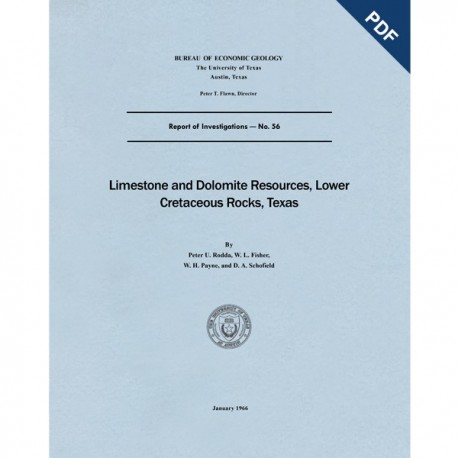
Limestone and Dolomite Resources, Lower Cretaceous Rocks, Texas. Digital Download
RI0056D
A free, digital version of this publication can be found on: Texas ScholarWorks
To purchase a print version (if available): RI0056
RI0056D. Limestone and Dolomite Resources, Lower Cretaceous Rocks, Texas, by P. U. Rodda, W. L. Fisher, W. R. Payne, and D. A. Schofield. 286 p., 22 figs., 4 plates, 1966. doi.org/10.23867/RI0056D. Downloadable PDF.
To purchase this publication in book format, please order RI0056.
ABSTRACT
Limestone is one of the most important nonfuel mineral resources in Texas. Annual production exceeds $30 million; value added in the manufacture of such products as cement and lime amounts to about $100 million annually. Lower Cretaceous limestone is the source of more than 40 percent of the State's total production of limestone and is utilized chiefly as crushed stone (aggregate and constructional stone), sources of raw materials for lime and portland cement, chemical and industrial process stone, agricultural limestone, fluxstone, and dimension stone. Lower Cretaceous dolomite is deadbumed to refractory dolomite.
Study of Lower Cretaceous limestone and dolomites (including Edwards, Comanche Peak, Goodland, Glen Rose, Devils River, and Salmon Peak Formations) from approximately 250 localities in 49 Texas counties in North Texas, Central Texas, Callahan Divide, Edwards Plateau, southeastern Balcones Escarpment, southern High Plains, and Trans-Pecos Texas, and of chemical analyses of approximately 1,000 samples delineates the occurrence, distribution, quality, reserves, and availability of these rocks as industrial raw materials.
Best stone in terms of physical and chemical quality occurs in the Edwards, Devils River, and Salmon Peak Formations; the only significant deposits of Lower Cretaceous dolomite are in the Edwards Formation. Other Lower Cretaceous limestones generally are too soft for use as a quality aggregate and insufficiently pure for use as chemical grade stone. Argillaceous limestone of the Goodland and Comanche Peak Formations is suitable raw material for portland cement. Total tonnage of Lower Cretaceous limestone (Edwards and associated formations) in outcrop in Texas amounts to approximately 8 trillion tons, about 40 percent of which contains 97 percent or more calcium carbonate (high-calcium limestone). Total tonnage of Lower Cretaceous dolomite (Edwards and associated formations) in outcrop amounts to about 450 billion tons, of which about 30 percent contains at least 16 percent magnesium oxide (high-magnesium dolomite). Of the total tonnage of 8.4 trillion tons of limestone and dolomite, approximately 6 percent, or 500 billion tons, is within competitive hauling distance of existing markets. Current annual consumption of limestone in Texas amounts to about 30 million tons.
Keywords: limestone, dolomite, mineral resources, portland cement, industrial minerals, Lower Cretaceous, Texas
Citation
Rodda, P. U., Fisher, W. L., Payne, W. R., and Schofield, D. A., 1966, Limestone and Dolomite Resources, Lower Cretaceous Rocks, Texas: The University of Texas at Austin, Bureau of Economic Geology, Report of Investigations No. 56, 286 p.. doi.org/10.23867/RI0056D.

